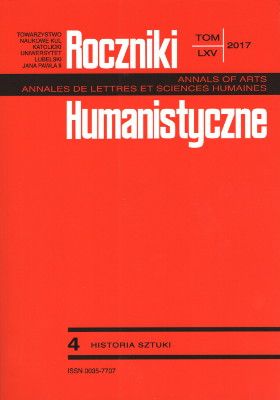Madonna in trono col Bambino di Bernardo Daddi nella collezione Lanckoroński del castello di Wawel
Madonna and Child Enthroned by Bernardo Daddi in the Lanckoroński family collection in the Wawel castle
Author(s): Szymon TraczSubject(s): Fine Arts / Performing Arts, Visual Arts
Published by: Towarzystwo Naukowe KUL & Katolicki Uniwersytet Lubelski Jana Pawła II
Keywords: Bernardo Daddi; Trecento; Santa Maria del Carmine; Florence; the Lanckoroński family collection; Madonna Enthroned; polyptych; panel; Heavenly Jerusalem
Summary/Abstract: Madonna and Child Enthroned in the Lanckoroński family collection in the Wawel castle (inv. No. 7908) along with the quarters with St. Bartholomew, St. Lawrence, St. Catherine and St. Cecilia that are preserved in other collections as well as with the panels that present the blessing Christ and the Evangelists used to be an essential part of a retable that can currently be found in various places across the world. The retable was made by Bernardo Daddi around 1340. It was intended to be a part of St. Bartholomew and St. Lawrence Chapel in the Carmelite church of Santa Maria del Carmine in Florence. After being divided into parts around 1750, the panel had become a part of the Viennese collection of Karol Lanckoroński (1848-1933) by the end of 1903. In 1994, the collection, including the previously mentioned panel, was placed in the Wawel Royal Castle, where it is held today. The composition and the ideological content of the quarter are closely related to an earlier confraternal altar panel from the church of Santa Maria del Carmine that includes Madonna and Child Enthroned with Two Angels as well as Christ Blessing between Two Angels placed at the top and originally separated with a frame. The altar panel, credited to Maestro della Sant’Agata (around 1270) is currently stored in the Brancacci chapel. The Wawel quarter is in line with Tuscan Madonnas that are defined in the iconography as the Regina Coeli or Maestà. A thorough analysis of ideological content presented on the Daddi panel based on source materials as well as an attempt to reconstruct the whole panel leads us to the conclusion that the retable made in Daddi’s workshop presented the vision of Heavenly Jerusalem, based on the Revelation to St. John. Through the Madonna and Child Enthroned with Two Angels panel the artist referred to the truth about the royal dignity of Mary and her participation in the mystery of the Incarnation and Redemption whereas Christ Himself was presented as the Lamb of God who took away the sins of the world. Therefore, the patron saints of the chapel worship Him. A holistic view of the Wawel panel and the way it is connected with the art of Tuscany shows that it is the object that, in artistic and formal terms as well as in content, is one of the most valuable examples of Italian Trecento that can be found in Polish collections.
Journal: Roczniki Humanistyczne
- Issue Year: 65/2017
- Issue No: 4
- Page Range: 5-33
- Page Count: 29
- Language: Italian

